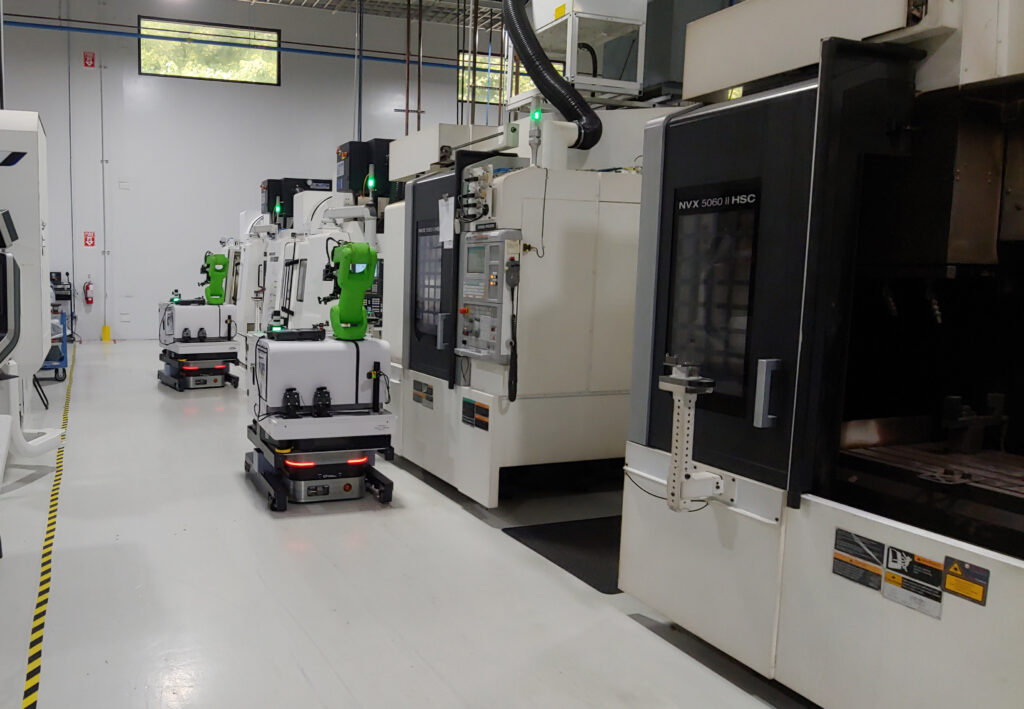This article by Matt Danford originally appeared in Modern Machine Shop magazine.
Buying new machine tools “automation-ready” is likely a good idea even without plans to pair them with robots. “If you ask (the supplier) to do a five-year-old machine, they have to send out technicians,” explains Thomas Post, operations manager at Capriol, an automation integrator.

Post should know. Capriol’s specialty is mounting robot arms atop freely roving automated guided vehicles (AGVs). The first of these systems was released relatively recently – in 2015 – and their focus is on work that many manufacturers would likely dismiss as impractical (or even impossible) to automate. Whatever the next five-odd years of automation bring to the independent CNC machine shops deeper in the supply chain, those who dismiss the potential for even basic machine tending might want to reconsider.
As for Capriol’s mobile machine tenders, Post says the best applications generally fall into two camps. One consists of parts that are large or otherwise difficult or risky to handle. For example, one customer uses the systems to move massive, dangerously hot glass billets around an extensive network of more than 80 large furnaces.
The other camp consists of work that moves through a series of both short- and long-run processes (one example has been posted on YouTube by Baker Hughes). For example, a mobile unit might break bottlenecks by moving parts from a single short-run machine to multiple longer-running machines. This strategy can reduce capital investment by reducing the required number of short-run machines and eliminating the need to place a robot at every workstation. “You don’t have to have every process on the line to complete a part,” Post explains.
Perhaps the most obvious benefit of mobile machine tending is freeing personnel from moving material or swapping parts from fixtures (perhaps with the aid of a crane). Mobile machine tending is particularly ideal as a more flexible alternative to robot rails or gantries. “If you want to change your process, you’re just clicking on a screen to set new waypoints,” Post says. “You don’t have to get a jackhammer and dig out the conveyor. You don’t need duplicate lines. You can use space more efficiently.”
Payloads range from 7 kg or less with smaller, lightweight collaborative robots to as heavy as 90 kg (nearly 200 lbs) with the industrial-grade arms on the largest systems. Although most units employ robots and AGVs from FANUC Robotics and Otto Motors, respectively, Capriol’s Panther DCS (distributed control system) can integrate any variety of arm or vehicle with shopfloor equipment and plant-wide management systems, Post says. Upon receiving instructions from the wireless plant network, the AGVs find their own way to their destinations, employing light detection and ranging (LIDAR) systems to navigate around obstacles (and even through wireless “dead spots”).
These same sensors feed machine learning algorithms employed by the AGV’s own fleet management software. The data they collect is employed to build and continually update the digital model of the facility. The longer the system runs, the better it becomes at finding the most efficient path through the point-and-click waypoints.
For the foreseeable future, Post expects customers to look mostly like existing ones: larger facilities and OEMs with applications that fit specific criteria (large parts and/or uneven processing steps). “This is not a replacement for robots that can sit in front of a machine for hours at a time, or those that can be easily wheeled around,” he says, adding that even automated systems take time to navigate and orient themselves to machines. “It could easily take two minutes just to get to the next station.”
Nonetheless, applications to date demonstrate the extent to which automation in general is expanding to include the previously impractical or impossible. Capriol’s relatively recent move from laboratory to field applications is a result of not only the company’s own effort, but also relatively recent developments in underlying technology, from longer-lasting lithium-ion batteries to AI. What’s more, further developments could offer just as much promise for the robot arm as for the AGV. (For example, a previous edition of this column covered how, with the aid of the latest force and vision sensors, AI could essentially give robot arms hand-eye coordination.)
In short, Post’s advice at the outset of this column — to be “automation-ready” — should likely apply to a manufacturer’s mindset as well as its equipment.